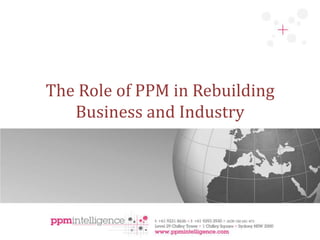
PMI Sydney Chapter Presentation 11 10 05
- 1. The Role of PPM in Rebuilding Business and Industry
- 2. Causes of the financial crisis “In the West, the break-up of the Soviet Union was viewed as a total victory … Western leaders were convinced that they were at the helm of the right system and of a well-functioning, almost perfect economic model … The dogma of free markets, deregulation and balanced budgets at any cost was force-fed to the rest of the world. But then came the economic crisis of 2008 and 2009, and it became clear that the new Western model was an illusion that benefited chiefly the very rich …[it] turned out to be unsustainable. It was based on a drive for super-profits and hyper-consumption for a few, on unrestrained exploitation of resources and on social and environmental irresponsibility”. – Mikhail Gorbachev, Sydney Morning Herald (June, 2009)
- 3. Causes of the financial crisis “One of the things you're supposed to learn in economics is to avoid extremes … A big part of the reason for the global financial crisis …was the dominance of an extreme view that the market system could work well with minimal government supervision. The problem comes when markets are seen as a ''system'' possessed of almost magical powers to never run off the rails and always deliver satisfactory outcomes without government interference …over the past 30 years, the intellectual fashion swung heavily in the direction of minimizing regulation. We dismantled a lot of the safety rails. The events of the global financial crisis were a stark reminder that …markets are far from perfect. They need to operate within a government-imposed framework and be diligently regulated to ensure rules are obeyed”. – Ross Gittens, Sydney Morning Herald (September, 2009)
- 8. Collusion
- 9. Price fixing
- 10. Cabal behaviour
- 13. Misleading and deceptive conduct
- 15. From mixed to market economy in the West
- 16. Glasnost, perestroika and the collapse of the Soviet Union
- 17. Miracle in South East Asia
- 18. Liberalisation and the awakening of India
- 20. The new game in Latin America
- 21. Keynesianism versus the Chicago School
- 23. Market-based instruments are regulations that encourage behaviour through market signals rather than through explicit directives regarding pollution control levels or methods. Firms and individuals are encouraged to undertake pollution control efforts in their own interests.
- 24. By way of contrast, conventional approaches to regulating the environment are often referred to as “command-and-control” regulations, since they allow relatively little flexibility in the means of achieving goals. Command-and-control regulations do this by setting uniform standards –
- 25. technology-based standards specify the method, and sometimes the actual equipment, that firms must use to comply with a particular regulation
- 27. Charge systems – e.g., effluent charges, deposit-refund systems, user charges, insurance premium taxes, sales taxes, administrative charges, and tax differentiation
- 28. Tradeable permit systems – e.g., credit programs and cap-and-trade systems
- 29. Reducing market frictions – e.g., market creation, liability rules, and information programs
- 31. Control costs can vary enormously due to a firm’s production design, physical configuration, age of its assets, or other factors. Because the costs of controlling emissions may vary greatly among firms, and even among sources within the same firm, the appropriate technology in one situation may not be appropriate (cost-effective) in another
- 36. Rigid centralized business planning – 5 year plans formulated by bureaucratic management in isolation of supply and demand considerations
- 37. Hierarchical control of resources – lack of autonomy and flexibility for the resources on the ground, inhibition of creativity
- 39. Rewarding management with bonuses for reducing pension fund liabilities – cabal behaviour, price fixing
- 40. Executives voting themselves excessive pay packets without entering into a bargaining process with organisational stakeholders – cabal behaviour, collusion and price fixing
- 42. The irrational investment decisions, driven by greed, short-termism, political expediency and incomplete knowledge, that were the immediate cause of the worst global financial crisis since the Great Depression, were not taken by individuals operating in a free market and merely following their own rapacious natures.
- 46. enabling comparison of the relative merits (value and risk) of investment options
- 47. providing the means to reasonably demonstrate that the best use of scare organisational resources is being made, and that investments are otherwise prudent
- 48. ensuring that the best resources flow to the most valuable projects
- 50. PPM portfolio and investment governance bodies and PMOs are
- 51. Entrusted with a role similar to the remit to ASIC and the ACCC to prevent anti-competitive behaviour and misuse of Company resources and assets by ensuring alignment of resource allocation decisions with prioritisation decisions
- 53. The opportunity cost of not being able to proceed with a project due to resource constraints provides a more rational means of quantifying the cost/benefit of new resource acquisition.
- 55. PPM has a critical role to play in the solutions currently being developed by governments and businesses to the twin problems of
- 56. How to most effectively manage the recovery from the Global Financial Crisis (GFC); and
